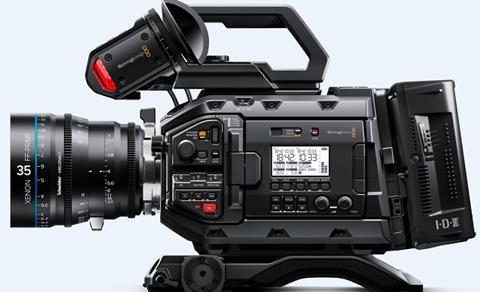Blackmagic Design has launched a new version of its Ursa camera and unveiled two grading panels.

The Blackmagic Ursa Mini Pro camera has a 4.6K image sensor with 15 stops of dynamic range.
Blackmagic chief executive Grant Petty said: “Ursa Mini has been a real success, however we wanted to design a new model that delivers many of the features customers have been asking for, so it’s even more powerful and faster to use.”
Petty described Ursa Mini Pro as “three cameras in one, because it combines high end digital film quality with the features and controls of a broadcast camera. This means it can be used for digital film, as well as broadcast and live production”.
An interchangeable lens mount allows users to switch between EF, PL (pictured above) and B4 lenses.
It includes built-in optical ND filters, an interchangeable lens mount and it records to CFast, SD and UHS-II cards.
“That means you can use CFast cards for full resolution, lossless 12-bit RAW recording, or smaller and low cost SD cards for 4K ProRes or RAW HD.
“With the dual slots, when one card is full, recording automatically continues onto the next card so you can keep shooting,” said Petty.
Formats supported by the camera include CinemaDNG 4.6K raw, ProRes 4444 XQ, ProRes 4444, ProRes 422 HQ, ProRes 422, ProRes 422 LT, ProRes 422 Proxy recording at Ultra HD and HD resolutions. It also supports raw 4.6K resolution capture at 60Fps.
The Blackmagic URSA Mini Pro is available now from Blackmagic Design resellers for £4,919.
Blackmagic has also launched hardware control panels for the company’s editing and colour correction software.
The smaller DaVinci Resolve Micro Panel has been designed to fit on a desk next to an editor’s keyboard.
The larger DaVinci Resolve Mini Panel includes the same features plus LCD screens for access to Resolve’s grading features.
“When it came to creating these new panels, the most important issues the design team wanted to solve were handling new workflows, enhancing creativity and quality,” said Petty.
“For workflows, we need to support professional colourists who edit and work on colour at the same time. But we also wanted to enhance creativity and improve quality as well.”

A row of 12 knobs provide access to primary correction features. They can be used to control Y Lift, Y Gamma, Y Gain, Contrast, Pivot, Mid-tone Detail, Colour Boost, Shadow, Highlight, Saturation, Hue Rotation and Luminance Mix.
The Mini Panel is priced at £2,405 while the Micro Panel is £805. Both are available now.
DaVinci Resolve 12.5.5, which was made available for download yesterday, is required to operate the new control panels.
Additionally, DaVinci Resolve and DaVinci Resolve Studio are now available on Red Hat and CentOS Linux.
“Adding Linux support to DaVinci Resolve gives you more powerful choices in hardware, making it possible to build extremely high performance, low cost workstations for editing and colour correction,” added Petty.






























No comments yet